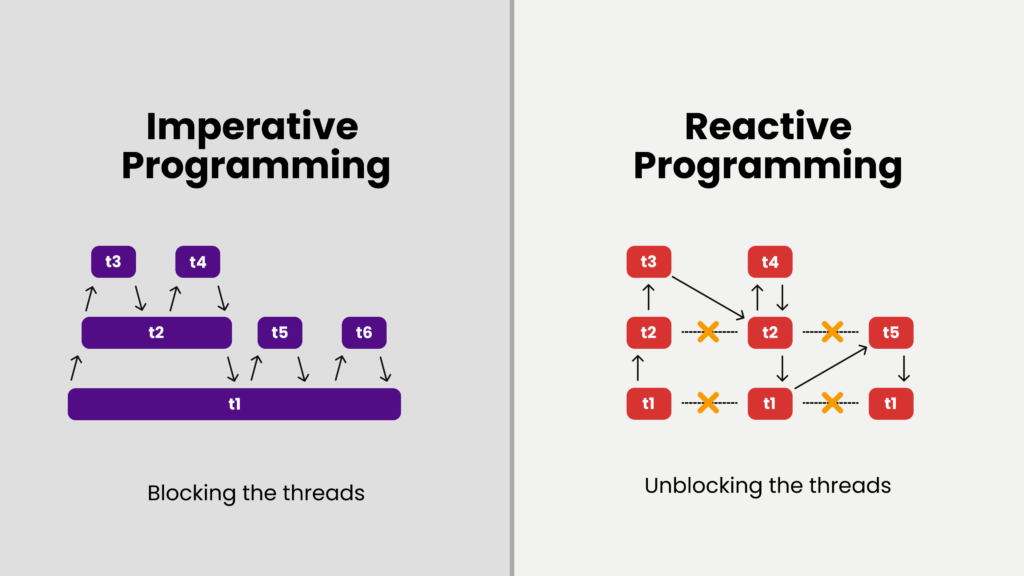Reactive Programming vs. Imperative Programming: Which One is Right for You?
In the dynamic landscape of software development, choosing the right programming paradigm is crucial for building efficient and maintainable applications. Reactive Programming and Imperative Programming are two distinct approaches, each with its own philosophy and benefits. In this blog post, we’ll embark on a journey to understand the fundamental differences between these paradigms and help you determine which one aligns better with your project’s requirements.
Reactive Programming Unveiled
Reactive Programming is a paradigm that revolves around the concept of reacting to changes and events. It’s particularly suited for applications that involve real-time data processing, event-driven architectures, and asynchronous operations. In reactive systems, data streams flow through various transformations, enabling developers to model complex behaviors elegantly. Prominent frameworks like RxJava, Reactor, and RxJS empower developers to harness the power of reactive programming.
Advantages of Reactive Programming:
- Responsive User Interfaces: Reactive programming excels when building interfaces that need to update promptly in response to user actions or changing data.
- Asynchronous Operations: Handling asynchronous tasks becomes more manageable with reactive paradigms, simplifying complex workflows and maintaining responsiveness.
- Data Streams and Pipelines: Reactive programming provides tools to process sequences of data with ease, allowing for efficient filtering, mapping, and merging operations.
- Scalability: Reactive systems are inherently equipped to handle high loads and scale gracefully due to their focus on asynchronous and non-blocking operations.
Imperative Programming Explored
Imperative Programming, on the other hand, follows a more sequential and step-by-step approach. It involves explicitly stating the sequence of actions to achieve a desired outcome. This paradigm is akin to how we give instructions in our daily lives, making it familiar to many developers. Popular programming languages like C, Java, and Python predominantly follow the imperative style.
Advantages of Imperative Programming:
- Straightforward Logic: Imperative programming’s linear flow makes it suitable for tasks that require a clear sequence of steps to reach the desired result.
- Fine-Grained Control: Developers have precise control over the execution order and memory allocation, which can be critical for optimization and performance tuning.
- Readability and Maintainability: Imperative code can often be more readable and easier to maintain, especially for small to medium-sized projects.
- Ease of Learning: For newcomers to programming, imperative style closely resembles logical thinking, facilitating an easier learning curve.
Choosing Your Path
Selecting the right programming paradigm depends on various factors, including the nature of your project, your team’s expertise, and the project’s long-term goals.
Opt for Reactive Programming When:
- Building real-time applications like collaborative tools, live dashboards, or interactive gaming platforms.
- Embracing the power of asynchronous processing and event-driven architectures is crucial.
- Working with data streams and transformations are integral parts of your application.
Demystifying Database Systems: MySQL vs. Microsoft SQL Server
Opt for Imperative Programming When:
- Tackling smaller projects or tasks that have a linear sequence of operations.
- Needing fine-grained control over resource allocation and execution order.
- Prioritizing readability and maintainability for projects that require less complex logic.
In the realm of software development, there’s no one-size-fits-all answer to the question of whether to choose Reactive or Imperative Programming. Both paradigms have their strengths and cater to distinct use cases. It’s essential to evaluate your project’s requirements, your team’s familiarity with each paradigm, and the long-term vision before making a decision. Whichever path you choose, understanding the strengths and nuances of both paradigms will empower you to create robust, efficient, and elegant software solutions.

